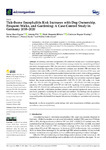2022-03-23Zeitschriftenartikel
Tick-Borne Encephalitis Risk Increases with Dog Ownership, Frequent Walks, and Gardening: A Case-Control Study in Germany 2018–2020
Nygren, Teresa Marie
Pilic, Antonia
Böhmer, Merle Margarete
Wagner-Wiening, Christiane
Wichmann, Ole
Harder, Thomas
Hellenbrand, Wiebke
In Germany, tick-borne encephalitis (TBE) infections mainly occur in southern regions. Despite recent increases in incidence, TBE vaccination coverage remains low, necessitating additional preventive strategies against TBE. Our case-control study in Southern Germany from 2018 to 2020 mapped knowledge/application of tick-protective strategies and identified TBE risk factors. We calculated odds ratios (OR), with 95% confidence intervals (CI). We interviewed 581 cases and 975 matched controls. Most participants recalled lifetime tick bites, mainly while walking, gardening, or hiking. However, only 45% of cases noticed ticks during exposure time; another 12% reported unpasteurized milk intake. While tick-protection knowledge was satisfactory, application lagged behind. Risk factors included dog ownership (OR = 2.45, 95% CI: 1.85–3.24), walks ≥ 4×/week (OR = 2.11, 95% CI: 1.42–3.12), gardening ≥ 4×/week (OR = 1.83, 95% CI: 1.11–3.02), and garden proximity < 250 m of forests (OR = 2.54, 95% CI: 1.82–3.56). Applying ≥2 tick-protective strategies (OR = 0.52, 95% CI: 0.40–0.68) and keeping lawns mowed (OR = 0.63, 95% CI: 0.43–0.91) were inversely associated with TBE. In 2020 (likely pandemic-related), cases reported significantly more walks than previously, potentially explaining the record high case numbers. Our findings provide guidance on targets for TBE prevention. Persons with gardens near forests, frequent outdoor activities, or dogs could particularly benefit from targeted information, including on vaccination and preventing tick bites.
Files in this item

